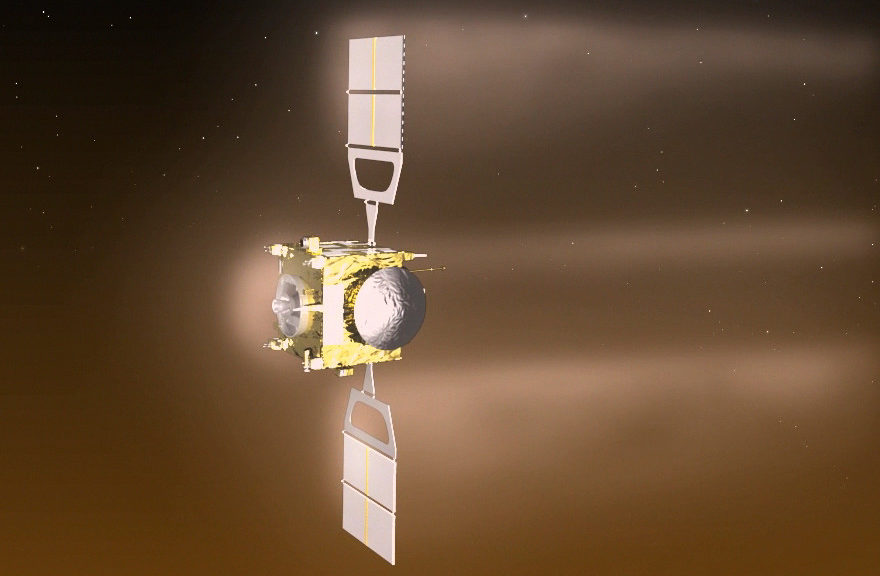
Artist impression of ESA’s Venus Express conducting special maneuvers to lower its orbit around Venus ((c) ESA–C. Carreau)
New Details of Venusian Atmosphere Revealed
The European Space Agency’s Venus Express orbited Earth’s closest planetary neighbor for over eight years until its mission ended in December 2014.
In its final months the spacecraft was sent deep into the Venusian atmosphere for a series of low-altitude orbits.
Studying data of a previously unexplored piece of the planet’s polar atmosphere, ESA scientists found it to be pulsing with atmospheric gravity and planetary waves.
The gravity waves were described as being similar to waves we see in the ocean, moving vertically but not horizontally.
Planetary waves are linked with the spin of a planet as it rotates on its axis
The Venus Express data showed the polar atmosphere to have an average temperature of -157°C, which is up to 70° colder than expected.
And at 130 to 140 kilometers above the Polar Regions the atmosphere’s density was between 22 and 40% less than had been predicted.

Colorized transmission electron micrograph (TEM) revealed some of the ultrastructural morphology displayed by an Ebola virus virion. (CDC/Frederick Murphy)
Fighting Many Types of Viruses At Once
Treating someone infected with viruses such as HIV, Ebola, influenza and Zika has always been a challenge.
Not only do they come in a variety of forms, viruses are known to quickly mutate and develop a resistance to drugs designed specifically to eliminate them.
Scientists looking to create anti-viral medications usually go after these nasty bugs one at a time.
But some are expanding their focus to develop drugs that will fight more than one type of virus at once.
Unfortunately some of the new methods used to fight multiple viruses may also be poisonous to healthy cells.
A team of Asian and American scientists say they’ve come up with a plan that fights a wide range of viruses, even those that mutate to develop resistance.
This new approach uses a polymer called polyethylenimine, that’s specially treated to make it non-toxic. This polymer electrostatically interacts with both viral and human cells to prevent infection.
Light Pulse Detected at Gravitational Wave Source
Back in February the LIGO Scientific Collaboration announced the first detection of gravitational waves that passed through our planet on September 14, 2015.
The waves of energy that traveled for 1.3 billion years were produced by the merger of two black holes.
NASA scientists say that less than a half second after the gravitational waves rocked the fabric of space-time, the Fermi Gamma-ray Space telescope was able to detect a quick and weak pulse of high-energy light from the same area of space.
NASA says this would be a remarkable discovery since mergers of black holes are thought to happen without producing any kind of light.
While their analysis indicates that this burst of energy has just a 0.2-percent chance of being just a coincidence, the scientists say they’ll need additional such observations before they can firmly associate spurts of high-energy x-rays with gravitational waves from black hole mergers.
Mice Sent into Space Return with Liver Problems
As NASA continues its plans to send people to deep space destinations such as Mars, the effects of long distance space travel on the human body needs to be better understood.
A new study in the journal PLoS ONE finds that mice who had flown aboard the space shuttle Atlantis came back to Earth with early symptoms of liver disease.
The mice at the center of the study orbited the Earth for 13.5 days on the final space shuttle flight in 2011, after which researchers from the University of Colorado’a Anschutz Medical Campus gathered and studied samples of their livers.
Their study found that the little space travelers had symptoms of nonalcoholic fatty liver disease, along with early signs of fibrosis, a mostly non-reversible condition that can lead to cirrhosis, which can be fatal.
The researchers plan to examine the livers of mice who fly in space for longer periods of time to see if there are any compensatory mechanisms that might protect them.

























Comments are closed.